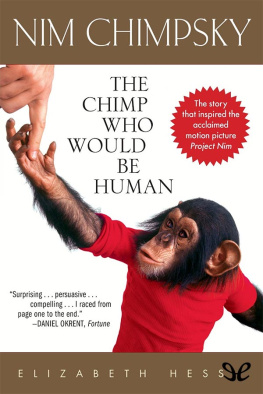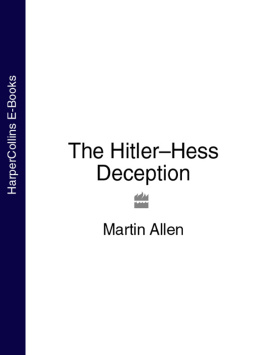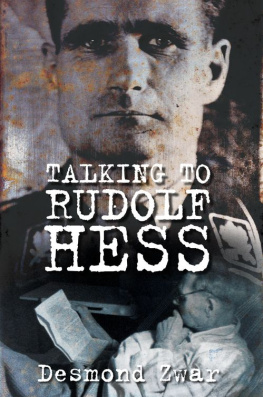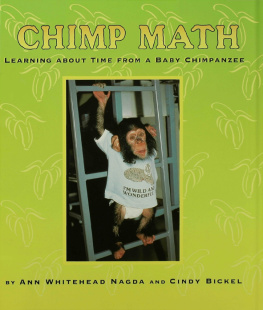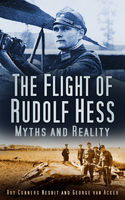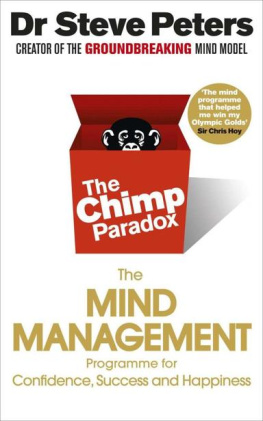Elizabeth Hess - Nim Chimpsky: The Chimp Who Would Be Human
Here you can read online Elizabeth Hess - Nim Chimpsky: The Chimp Who Would Be Human full text of the book (entire story) in english for free. Download pdf and epub, get meaning, cover and reviews about this ebook. year: 2008, publisher: ePubLibre, genre: Detective and thriller. Description of the work, (preface) as well as reviews are available. Best literature library LitArk.com created for fans of good reading and offers a wide selection of genres:
Romance novel
Science fiction
Adventure
Detective
Science
History
Home and family
Prose
Art
Politics
Computer
Non-fiction
Religion
Business
Children
Humor
Choose a favorite category and find really read worthwhile books. Enjoy immersion in the world of imagination, feel the emotions of the characters or learn something new for yourself, make an fascinating discovery.
- Book:Nim Chimpsky: The Chimp Who Would Be Human
- Author:
- Publisher:ePubLibre
- Genre:
- Year:2008
- Rating:4 / 5
- Favourites:Add to favourites
- Your mark:
- 80
- 1
- 2
- 3
- 4
- 5
Nim Chimpsky: The Chimp Who Would Be Human: summary, description and annotation
We offer to read an annotation, description, summary or preface (depends on what the author of the book "Nim Chimpsky: The Chimp Who Would Be Human" wrote himself). If you haven't found the necessary information about the book — write in the comments, we will try to find it.
Nim Chimpsky: The Chimp Who Would Be Human — read online for free the complete book (whole text) full work
Below is the text of the book, divided by pages. System saving the place of the last page read, allows you to conveniently read the book "Nim Chimpsky: The Chimp Who Would Be Human" online for free, without having to search again every time where you left off. Put a bookmark, and you can go to the page where you finished reading at any time.
Font size:
Interval:
Bookmark:
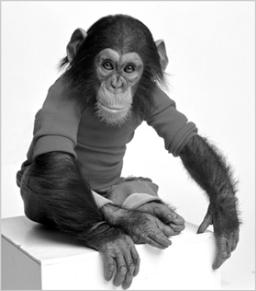

Elizabeth Hess
ePub r1.0
nalasss 22.10.14
Could an adorable chimpanzee raised from infancy by a human family bridge the gap between speciesand change the way we think about the boundaries between the animal and human worlds? Here is the strange and moving account of an experiment intended to answer just those questions, and the astonishing biography of the chimp who was chosen to see it through.
Dubbed Project Nim, the experiment was the brainchild of Herbert S. Terrace, a psychologist at Columbia University. His goal was to teach a chimpanzee American Sign Language in order to refute Noam Chomskys assertion that language is an exclusively human trait. Nim Chimpsky, the baby chimp at the center of this ambitious, potentially groundbreaking study, was adopted by one of Dr. Terraces graduate students and brought home to live with her and her large family in their elegant brownstone on the Upper West Side of Manhattan.
At first Nims progress in learning ASL and adapting to his new environment exceeded all expectations. His charm, mischievous sense of humor, and keen, sometimes shrewdly manipulative understanding of human nature endeared him to everyone he met, and even led to guest appearances on Sesame Street, where he was meant to model good behavior for toddlers. But no one had thought through the long-term consequences of raising a chimp in the human world, and when funding for the study ran out, Nims problems began.
Over the next two decades, exiled from the people he loved, Nim was rotated in and out of various facilities. It would be a long time before this chimp who had been brought up to identify with his human caretakers had another opportunity to blow out the candles on a cake celebrating his birthday. No matter where he was sent, however, Nims hard-earned ability to converse with humans would prove to be his salvation, protecting him from the fate of many of his peers.
Drawing on interviews with the people who lived with Nim, diapered him, dressed him, taught him, and loved him, Elizabeth Hess weaves an unforgettable tale of an extraordinary and charismatic creature. His story will move and entertain at the same time that it challenges us to ask what it means to be human, and what we owe to the animals who so enrich our lives.
For Nim, Pete, Kat,
and the other beasts in my life
what is most unexpected is language
the way it threads us through and through
we the knots tied in the net
our lives the fish we catch in it
W.E.R. LaFarge
(how we are connected)
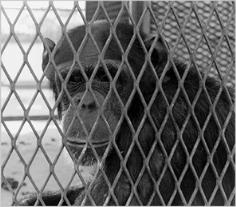
Nims mother, Carolyn, in Norman, Oklahoma
The Unexpected Birth of Nim Chimpsky
NOVEMBER 19, 1973, BEGAN like any other day at the Institute for Primate Studies (IPS) in Norman, Oklahoma. There, on the outskirts of town, where suburbia fades into rolling farmland, a motley group of forty chimpanzees hooted and shrieked in anticipation of their breakfast. Emily Sue Savage (now known as Sue Savage-Rumbaugh), a graduate student at the University of Oklahoma and a regular visitor to the chimp houses at IPS, no longer cringed at the sound of this earsplitting racket. Savage spent most of her days at this research facility, collecting data for her forthcoming dissertation on mother-infant behavior in captive chimpanzees.
The chimps were in two different buildings, one of which was attached almost like an in-law apartment to the house that belonged to Dr. William Burton Lemmon, Savages mentor and the director of the Institute. This building was where Lemmons adult chimps lived and where Savage went to observe mothers and newborns during their first few weeks together. Most graduate students never went near the adult chimps, preferring to spend time with the much more amusing, less hostile adolescents, who were tucked away in a barn located a short distance from Lemmons house. But Savage had chosen to study the older, bigger females. She had become inured to their odors, their aggressive gestures, and even the jets of water (or feces) they spat at her face; she understood their anxieties and appreciated their sense of humor. The budding young scientist, who would later become world famous for her groundbreaking language research with her own colony of bonobos, had clocked so many hours with these chimps that she identified more with them than with her fellow students.
That afternoon, Savage was observing Carolyn, a wild-born, eighteen-year-old female, when she saw her bend over and pull a small, dark form out of her massive body. There was no mistaking the dripping, writhing package. Trying to blend into the scene as unobtrusively as possible, Savage sat quietly and watched as Carolyn, an experienced mother, began to hug and groom her new baby, her seventh. A few critical seconds ahead of the chimps who shared quarters in the building, Savage closed one of the guillotine doors separating the cages from each other to give Carolyn some privacy and some protection from her mates. After several more minutes of focused observation, Savage went to spread the news.
Savages teacher, the charismatic and highly unconventional William Lemmon, felt as proud of each newborn delivered by one of his chimps as if he had played a part in their creation. He rarely missed the advent of a pregnancy or, for that matter, any other development in his chimpanzee colony. But he had not known that Carolyn was pregnant, much less that she was about to give birth. She had produced six infants over the past four years (including two sets of twins) and Lemmon felt she needed a rest, so he had put her on birth control pills, the same kind that humans take, in an early experiment in primate population control. Carolyn was one of the first chimps on the pill. But apparently the pill is not foolproof for any species.
As soon as he heard the news from his student, Lemmon rushed to Carolyns cage and found her cradling the damp, sputtering infant. This baby, as adorable as his older siblings, had protruding ears, saucer eyes the color of maple syrup, and string bean arms and legs. When he cried, Carolyn issued a rhythmic stream of whimpers that had an instant calming effect, almost like a lullaby. She ran her lips over every inch of his skin, gently kissing and grooming him from head to toe.
Grooming, an activity that cements the bond between chimp mother and child, begins at birth. In the wild, mother and child often remain together for three or four years, in constant physical contact with each other, while the youngster receives detailed instruction in the fine art of jungle survival. In captivity, the bonding process and with it the lessons passed along from one generation to the next may not remain intact; chimp mothers frequently reject their infants, refusing even to hold them after giving birth. Its as if their maternal instincts have been switched off, sometimes temporarily, sometimes forever. Like humans, chimpanzees can suffer from severe depression.
But Carolyn was an ideal mother. She held her baby close to her with one arm while she swatted away flies with her other hand. Then she leapt up onto a perch in her cage and turned her back toward her audience to face the wall, preventing Lemmon and the others in the small group that had gathered from seeing her baby. The gesture made a powerful statement, which none of them had any trouble understanding. Carolyn knew the drill. She would not have long to experience the pleasurable thrall of motherhood. This baby, like all her others, would soon be taken from her, destined for one of the research projects to which Lemmon sent most of the chimps born at IPS. As it happened, number 37, as he was listed in Lemmons primate records, was slated for a prestigious ape language study at Columbia University, which the lead scientist had dubbed Project Nim after its research subject, who was intended to bear the name Nim Chimpsky. Carolyns baby, known as Nim throughout his life, was taken from his mother ten days later.
Next pageFont size:
Interval:
Bookmark:
Similar books «Nim Chimpsky: The Chimp Who Would Be Human»
Look at similar books to Nim Chimpsky: The Chimp Who Would Be Human. We have selected literature similar in name and meaning in the hope of providing readers with more options to find new, interesting, not yet read works.
Discussion, reviews of the book Nim Chimpsky: The Chimp Who Would Be Human and just readers' own opinions. Leave your comments, write what you think about the work, its meaning or the main characters. Specify what exactly you liked and what you didn't like, and why you think so.

